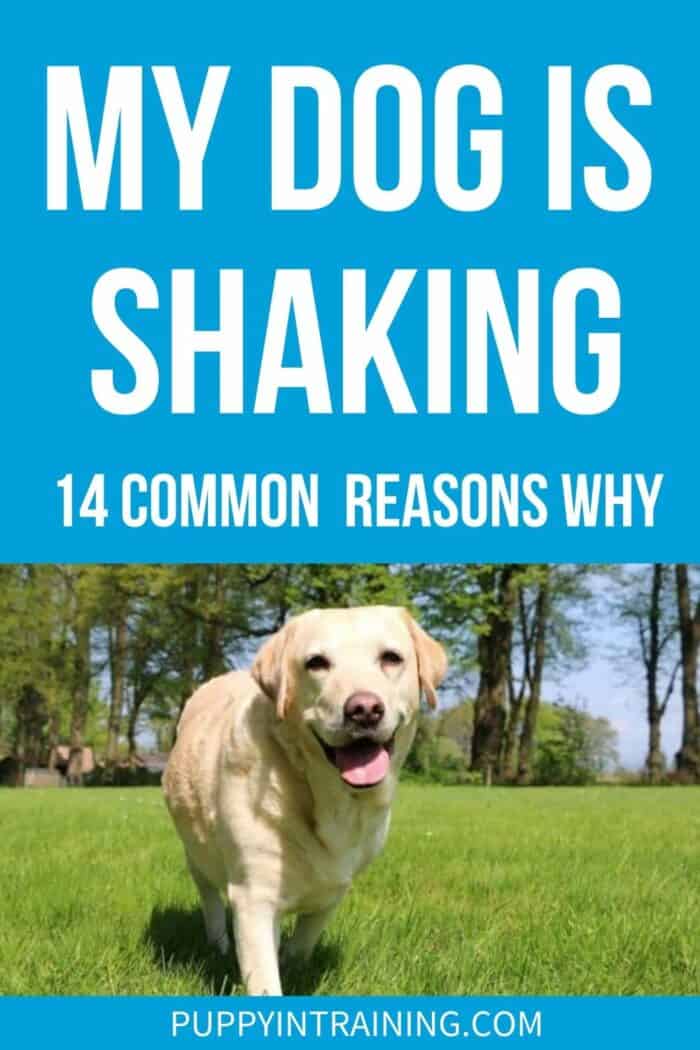This post may contain affiliate links. We may earn money or products from the companies mentioned in this post.
As a dog owner, you’ve likely seen your dog shaking and trembling when it’s excited.
Such adorable behavior has maybe even made you laugh. But if you’ve ever seen your dog’s trembling paired with out-of-the-norm behavior, then you know it’s anything but funny.
What causes a dog to tremble and act strangely? Is there anything you should do for a dog that’s shaking and acting weird? When is it time to take your dog to the vet?
These are all questions you may be asking yourself as you watch your beloved pet exhibit uncharacteristic behavior.

In this article, we discuss 14 reasons your dog may be shaking and acting weird, what you should do if you notice any tremors, and when it is time to take your dog to the vet.
We are not veterinarians. If you ever notice a health issue with your dog we recommend consulting with your vet immediately.
Less Critical Reasons Your Dog May Be Shaking
1. Your Dog Is Excited, Or Has Just Been Active
Excitement is the #1 cause of shaking in dogs. Whether it happens when a new friend stops by the house or after a particularly excellent game of fetch, shaking from excitement is a natural reaction that occurs as the dog releases any excess energy.
If you have an 8 week old puppy then getting overly excited might be a common occurrence for both the puppy and anyone visiting. Even humans might shake with excitement when seeing a new pup. 🙂
2. Your Dog Is Stressed Or Anxious
Fear, stress, and anxiety can also cause your dog to shake and act in a way that isn’t normal. Common triggers of stress tremors include fireworks, big environmental changes, or fear of physical harm.
Shaking due to stress is often accompanied by an arched back, the tail between the hind legs, hiding in a small space, and whimpering.
If your dog is prone to anxiety, then it is worth consulting your veterinarian. Your vet can prescribe anti-anxiety medication that you can give to your pet when you know something stressful is about to occur.
3. You Dog Is “In Heat”
The term “in heat” refers to the time when female dogs that are not spayed experience ovulation and become receptive to mating. This usually occurs twice each year, and signs include trembling, restlessness, more frequent urination, and behavior that might seem like nervousness.
If your dog is in heat and shaking, then there is really no need to consult a veterinarian. Longer walks and some additional exercise can help get rid of that extra energy, while treats and toys can keep her busy and distracted.
4. Your Dog Is Cold
Just like us humans, dogs get cold and shiver when they do. You will have a pretty good idea that your dog is cold if it is shaking but not exhibiting any other serious symptoms.
Dogs will get chilled starting at about 45 degrees Fahrenheit. If your dog has to be outside in such a temperature, then it may be worth investing in a coat and/or a pair of doggy booties.
It’s important to bring your dog indoors in temps that are close to freezing. Though we’ve included “cold” on our list of less critical reasons, dogs that are left outside in cold temperatures for long periods of time run the risk of hypothermia. If you find a dog that is shivering from exposure, then the dog is likely to require veterinary treatment.
More Critical Reasons Your Dog May Be Shaking
5. Your Dog Is Feeling Nauseated
Just like humans, dogs might get nauseated from medication, motion sickness, or eating too much or the wrong thing. But because nausea can also be a symptom of more serious illness, we’ve included it on the list of more critical reasons your dog may be shaking.
Trembling and odd behavior can be signs that your dog is feeling nauseated, along with other symptoms like excessive salivation, lip smacking, listlessness, and vomiting.
If your dog exhibits signs of nausea for an extended period of time, then it may be worth checking in with your veterinarian.
6. Your Dog Is Suffering From Heat Exhaustion
Heat exhaustion is a very real danger for dogs, especially dogs that are large, have thick coats, have flat faces, or that are obese or elderly.
If your dog is suffering from heat exhaustion, then you are likely to notice shaking in the form of shivering. Excessive panting and salivation are additional signs of heat stroke in dogs.
A dog’s body temperature should never reach higher than 104 degrees. Humidity and hot enclosed spaces, such as a car, are especially dangerous, as they do not allow the dog the opportunity to cool themselves through panting.
You can avoid heat exhaustion by always providing your dog plenty of water and shade when it is outside, and by never leaving your dog in the car on a warm day.
7. Your Dog Is Old And/Or Pain
As a dog ages and its body weakens, some trembling is bound to happen. Generally, shaking due to old age occurs in a dog’s pelvic area or throughout their hind legs. This kind of trembling doesn’t usually affect the way the dog walks and moves.
While most trembling in an old dog is harmless, older dogs are more prone to injury and arthritis, a symptom of which can be some shaking. For that reason, it’s recommended that older dogs that develop the shakes be checked out by their veterinarian. If it turns out the dog is shaking out of pain, then the veterinarian can make further recommendations.
8. Your Dog Has Been Poisoned
Shaking and erratic behavior are major signs that your dog has ingested something poisonous. Other signs might include vomiting, excessive salivation, dry heaving, a racing heart, or pale gums, among other things.
Besides things like chemicals, dogs can be poisoned by typical household items such as chocolate, cigarettes, and xylitol (a common sugar substitute, especially for chewing gum). Dangerous items kept outdoors where a curious dog might come across them include mouse and rat poison, lawn fertilizer, and snail bait, the latter of which can cause very severe convulsions and muscle tremors.
If you suspect your dog has been poisoned, it is recommended that you visit your nearest emergency vet as soon as possible. You can also give the ASPCA Animal Poison Control Center a call.
9. Your Dog Has Distemper
Canine distemper is a very serious malady that affects puppies and young dogs that have not been vaccinated. Caused by a virus, it is often fatal. Those dogs and puppies that do survive tend to have permanent damage to their nervous systems.
Infected animals spread distemper through the air by coughing or sneezing. The distemper virus can also be transmitted to healthy dogs through shared bowls or toys. Fortunately, distemper is easily avoided by vaccinating puppies with the DHPP (distemper, hepatitis, parainfluenza, and parvovirus) vaccine.
If your dog begins trembling and is an unvaccinated puppy or adolescent dog, then distemper could very well be the culprit. Other signs of distemper include fever, coughing, and discharge from the eyes and nose.
10. Your Dog Has Generalized Tremor Syndrome (GTS)
Generalized Tremor Syndrome also goes by the names steroid responsive tremor syndrome and white shaker dog syndrome. The latter got its name because it was first noticed in dogs like West Highland terriers and Maltese, though in actuality, it can affect any breed, size, or color of dog.
GTS causes shaking that is repetitive, rhythmic, and involuntary. The dog’s entire body may shake, or just one area like its head or hind end.
It is currently not known what causes GTS, though some veterinarians believe it to be autoimmune related. Diagnosing GTS is a process “of exclusion,” meaning if your veterinarian suspects GTS, then they will first rule out all other possibilities.
11. Seizures
Unfortunately, seizure disorders like epilepsy are relatively common in dogs. If your dog has a seizure, it will fall on its side before continuously moving its legs as if it’s running or swimming.
Seizures are not painful for dogs, but they are dangerous because dogs can fall and hit something as the seizure begins. If you witness your dog having a seizure, it is vital that you contact your veterinarian right away. Once diagnosed, your vet will likely prescribe your dog seizure-controlling medications like phenobarbital, keppra, or potassium bromide.
12. Your Dog Has Bloat
In humans, bloat isn’t always a big deal. But if your dog has bloat, then it is considered a medical emergency.
Bloat is officially known as gastric dilatation and volvulus (GDV) or stomach torsion. It is a very painful and stressful malady in which the dog’s stomach twists around itself and becomes twisted at either end. This blocks blood flow and the escape of gas and other stomach contents, which causes the extreme bloat. GDV can be caused by any number of things, the most common of which include heart failure, internal bleeding, and liver dysfunction.
Besides extreme trembling, a dog with bloat will be restless and unable to lie down. It may be dry heaving, or trying to vomit, though unsuccessfully. Rapid shallow breathing and biting at its stomach are other signs.
If your dog looks bloated at all, then it is recommended that you take it to the nearest emergency vet as soon as possible. If you can, call the veterinarian while you are on your way so that they can be prepared for your dog’s arrival.
13. Your Dog Has Cushing’s Disease
Cushing’s disease, known officially as hyperadrenocorticism, occurs when a dog’s adrenal glands produce too much cortisol. The extra cortisol in the body increases the dog’s chance of coming down with a variety of illnesses, including diabetes and kidney damage. Cushing’s disease is very serious, and most dogs live just two years past diagnosis.
Cushing’s disease mostly affects middle-aged and elderly dogs. If your dog develops a tremor due to Cushing’s disease, you will likely notice some other symptoms, too. Cushing’s disease causes dogs to eat, drink, and urinate far more than usual. You will also notice quite a bit of lethargy.
14. Your Dog Has Addison’s Disease
The opposite of Cushing’s disease is Addison’s disease. Officially known as hypoadrenocorticism, Addison’s disease occurs because the dog’s adrenal glands are not producing enough cortisol. Without this important steroid, a dog’s internal organs cannot work properly.
Though the process is different, the symptoms of Addison’s disease are similar to those of Cushing’s disease. Shaking, lethargy, and increased urination are common symptoms, as are diarrhea, a weak pulse, and weight loss.
What To Do If Your Dog Is Acting Weird And Shaking
You know your dog best, so trust your gut when it comes to whether or not your dog is acting in a way that is not normal.
If you notice your dog behaving oddly and shaking, then your first step is to remain calm and rational. You will need to be able to get an accurate read on any symptoms in case you need to relay the situation to your veterinarian.
Next, take stock of any other strange symptoms. Other symptoms that tend to occur with shaking include:
- Labored breathing
- Lethargy
- Ataxia (loss of coordination)
- Excessive swallowing and drooling
- Nausea
- Listlessness
- Vomiting
Make a quick observation of the immediate environment. Is there a storm outside? Have you brought out a suitcase to pack for a vacation? Is there anything there that might be causing your dog stress?
Consider recent behavior. Has your dog been eating and drinking less? Has it been as excited as usual about walks, car rides, and toys?
Consider past behavior. Has your dog ever started shaking before? If so, do you notice anything now that you also noticed then?
Take a quick scan around the room to see if you notice any foods or other toxins your dog may have gotten into.
Use your cell phone to take a video of your dog shaking and acting strangely. If you decide you need to take your dog to the veterinarian, then having a video of the behavior could prove extremely helpful.
When A Shaking Dog Needs To See The Vet
There are far more critical reasons that a dog might be shaking than there are non-critical reasons. It should be fairly simple to determine if your dog is shaking because it is excited (is its tail wagging too?) or feeling anxious. If you have a gut feeling that it is something else, then it is worth reaching out to your veterinarian.
If you do not notice any immediate secondary symptoms such as vomiting, listlessness, ataxia, or labored breathing, then give your veterinarian a call to find out what they recommend. Chances are they will ask you to come in at your earliest convenience, but it is worth checking.
If you do notice immediate secondary symptoms – and especially if your dog’s stomach is extended or bloated – then you will need to drop what you are doing and take your dog to the nearest emergency veterinarian.
Don’t be afraid to call the emergency animal hospital as you are leaving the house or on your way to let them know you are bringing in your dog that has been shaking and acting strangely. If the veterinarians have a little bit of a head’s up, then they can be prepared for immediate treatment.
Frequently Asked Questions
What should I do if my dog is shaking?
If your dog is shaking, the first thing to do is remain calm and consider potential sources of anxiety, such as thunderstorms.
If your dog is not anxious or nervous, then shaking could be a sign of something more serious. If your dog’s shaking began suddenly and you notice symptoms like an extended belly, vomiting, or diarrhea, then it’s time to get to a veterinarian.
Why is my dog shaking, but still acting normal?
There are a number of reasons a dog may start shaking, some more serious than others. If you notice shaking, but no other symptoms, then it is likely your dog is excited or anxious about something.
However, if the shaking continues, or your dog begins vomiting, having diarrhea, acting lethargic, or anything else that is out of the norm, then it’s worth checking in with your vet.
How can I stop my dog from shaking with anxiety?
Just like humans, dogs are affected by stressful and scary situations. If your dog is shaking during a thunderstorm, at the prospect of you leaving, or other anxiety-inducing situation, then there are a few things you can try to help it calm down:
- Turn on the television or radio as a distraction or form of “company”
- Physical contact
- A calming coat or a t-shirt that smells like you
- Veterinarian-prescribed anti-anxiety medication
The Bottom Line
When it comes to our beloved dogs, it is a very fine line between normal trembles of excitement and shaking that is more sinister. There are quite a few emergency situations that could cause your dog to shake and act strangely, including seizures, bloat, poisoning, and various diseases like Cushing’s disease and distemper.
If you suspect your dog is shaking due to something other than excitement, sexual arousal, or anxiety, then it’s helpful to stop and take stock of things like the dog’s immediate environment, any other symptoms, and possible dangers. Taking a video of your dog’s behavior with your cell phone for your vet to review could also prove to be life saving.
Most episodes of shaking will need to be seen by a vet as soon as possible. In some scenarios, a call to your normal vet for his or her recommendations will suffice. However, if you notice emergent symptoms such as shaking and vomiting, stomach bloating, labored breathing, ataxia, or lethargy, then it is necessary to stop what you are doing, call your local emergency veterinarian, and go.
Shaking and strange behavior in dogs could be very, very serious, and even life threatening. In far too many cases for comfort, careful observation and quick action on your part could very well save your pet’s life.
Save To Pinterest

Top Picks For Our Puppies
- BEST PUPPY TOY
We Like: Snuggle Puppy w/ Heart Beat & Heat Pack – Perfect for new puppies. We get all of our Service Dog pups a Snuggle Puppy. - BEST DOG CHEW
We Like: Best Bully Sticks – All of our puppies love to bite, nip, and chew. We love using Bully Sticks to help divert these unwanted behaviors. - BEST DOG TREATS
We Like: Wellness Soft Puppy Bites – One of our favorite treats for training our service dog puppies. - BEST FRESH DOG FOOD
We Like: The Farmer’s Dog – A couple months ago we started feeding Raven fresh dog food and she loves it! Get 50% off your first order of The Farmer’s Dog.
Check out more of our favorites on our New Puppy Checklist.


